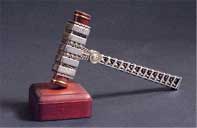Commencement originated in the Middle Ages when university graduates were initiated into the teaching profession. The colorful academic procession that begins the ceremony is rooted in pageantry of the great medieval universities of Europe. These schools were usually in the charge of the clergy, and the order of march followed the tradition of religious processions: younger and newer groups preceded the older, with the highest-ranking participants at the end.
The academic costumes vary mostly by the colorful hoods. The gowns of most universities in this country are black, however Yale, Harvard and many foreign universities have brilliantly colored gowns. The shortest hood is the bachelor's; the longest and broadest is the doctor's; and the master's is midway between these in size. The hoods, worn over the shoulders and down the backs of the faculty, indicate the degrees and the institutions of the wearers: the lining of the hood, in silk, gives the color or colors of the institution granting the degree, while the color of the velvet binding or edging designates the subject of the degree earned.
Among the most frequently seen colors are:
- Architecture - Blue-Violet
- Arts, Letters, Humanities - White
- Business - Drab
- Economics - Copper
- Education - Light Blue
- Engineering- Orange
- Fine Arts - Brown
- Journalism - Crimson
- Law - Purple
- Medicine - Green
- Music - Pink
- Philosophy - Dark Blue
- Science - Golden Yellow
- Social Science - Cream
The City College's first Commencement took place in 1853 at Niblo’s Gardens, when seventeen young men graduated from the Free Academy, as the College was then known.
The ceremony begins with music as the degree candidates march to their seats. Degree candidates, led by the deans of their respective schools or divisions and the valedictorians and salutatorians of each school or division, march first, followed by alumni celebrating their 50th, 25th and 10th reunions, followed by the faculty. The final marchers will be members of the platform party, including deans, officers of the College, university representatives, honorary degree recipients and the Provost and the President.
The Chief Marshal precedes the President and carries the mace. Now purely ceremonial, the tradition dates back to medieval England, when an official taking office or opening courts needed a bodyguard. In those times the mace, or spiked club, was a formidable weapon that was held ready to protect the official.
The Mace

The mace of The City College, designed and built by Bernard Bernstein of the Department of Industrial Education in 1982, incorporates in its design various symbols associated with the College. The beaver forms the filial of the mace; the six flanges, transformed from the spikes of a medieval hand weapon, echo the wrought iron and masonry arches spanning Convent Avenue; below the flanges, the circular designs symbolize the schools of the College; the three medals at the base repeat the seal of the College. The principal materials of the mace include a walnut shaft with sterling silver mounts and gold plated emblems.
The Gavel

The gavel is carried by the Provost, who is the chief academic officer of the College. It was given to the College in 1958 in honor of our founder, by his grand nephew, Richard H. Rush. Designed by Professor Simon Lissim of the Department of Art, the ceremonial gavel is made of gold and silver and has ends of Brazilian rosewood. A ribbon engraved with the names of the College's presidents encircles the handle. The names of the schools of the College are engraved on the hammer, and the college seal is set into the two sides of the handle.
Last Updated: 06/14/2016 14:56